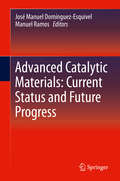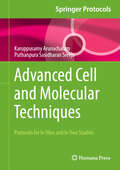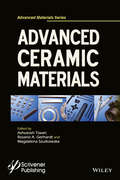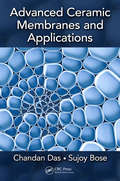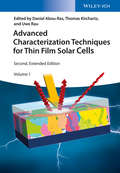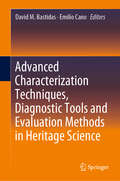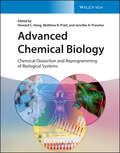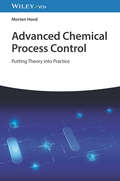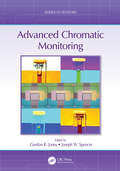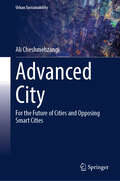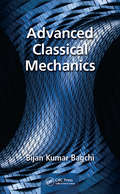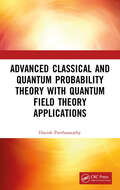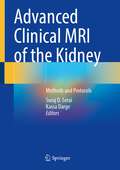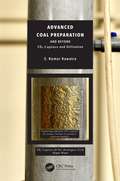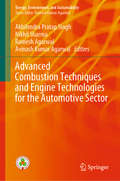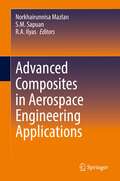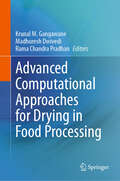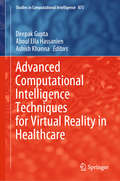- Table View
- List View
Advanced Catalytic Materials: Current Status and Future Progress
by José Manuel Domínguez-Esquivel Manuel RamosThis book presents advances in computational methods, experimental synthesis, and advanced characterizations for novel catalytic materials. The authors show how catalytical materials can be used for various engineering oil & gas applications – mainly in low contaminants fuel production. All contributors, describe in detail novel experimental and theoretical techniques techniques and concepts for synthesis, evaluation and scaling catalytic materials and research advances in evaluation, extensive characterization and theoretical modeling using computer assisted methods and algorithms.Describes computational methods, experimental synthesis and advanced characterization for novel catalytic materials;Examines catalytic materials and corresponding engineering applications with a focus on low contaminant fuel production and derivatives;Covers the application of computer assisted quantum mechanical for fundamental understanding of electronic structure of molecular dimension catalytic materials.
Advanced Cell and Molecular Techniques: Protocols for In Vitro and In Vivo Studies (Springer Protocols Handbooks)
by Karuppusamy Arunachalam Puthanpura Sasidharan SreejaThis detailed volume explores laboratory protocols and methodologies for studying cell cultures, genetic analysis, and various biochemical assays. The chapters within this book cover a wide range of techniques, from basic cell culture methods to more specialized assays used in the study of genotoxicity, apoptosis, and gene expression, not only relevant to academic researchers but also to professionals in the pharmaceutical, biotechnological, and clinical fields. Written for the Springer Protocols Handbooks series, each protocol has been carefully compiled to provide step-by-step instructions, ensuring clarity and reproducibility. Authoritative and practical, Advanced Cell and Molecular Techniques: Protocols for In Vitro and In Vivo Studies serves as both a hands-on guide and a source of inspiration for future research as the fields of molecular biology and toxicology continue to evolve.
Advanced Ceramic Materials
by Ashutosh Tiwari Magdalena Szutkowska Rosario A. GerhardtCeramic materials are inorganic and non-metallic porcelains, tiles, enamels, cements, glasses and refractory bricks. Today, "ceramics" has gained a wider meaning as a new generation of materials influence on our lives; electronics, computers, communications, aerospace and other industries rely on a number of their uses. In general, advanced ceramic materials include electro-ceramics, optoelectronic-ceramics, superconductive ceramics and the more recent development of piezoelectric and dielectric ceramics. They can be considered for their features including mechanical properties, decorative textures, environmental uses, energy applications, as well as their usage in bio-ceramics, composites, functionally graded materials, intelligent ceramics and so on. Advanced Ceramic Materials brings together a group of subject matter experts who describe innovative methodologies and strategies adopted in the research and development of the advanced ceramic materials. The book is written for readers from diverse backgrounds across chemistry, physics, materials science and engineering, medical science, pharmacy, environmental technology, biotechnology, and biomedical engineering. It offers a comprehensive view of cutting-edge research on ceramic materials and technologies. Divided into 3 parts concerning design, composites and functionality, the topics discussed include: Chemical strategies of epitaxial oxide ceramics nanomaterials Biphasic, triphasic and multiphasic calcium orthophosphates Microwave assisted processing of advanced ceramic composites Continuous fiber reinforced ceramic matrix composites Yytria and magnesia doped alumina ceramic Oxidation induced crack healing SWCNTs vs MWCNTs reinforcement agents Organic and inorganic wastes in clay brick production Functional tantalum oxides Application of silver tin research on hydroxyapatite
Advanced Ceramic Membranes and Applications
by Chandan Das Sujoy BoseThis book provides a balanced blend of fundamental concepts of fabrication, characterization of conventional ceramics, extending to present the recent advances in ceramic membranes. It covers the basic concepts of ceramic membranes as well as practical and theoretical knowledge in conventional and advanced ceramic membranes combined with unorthodox ideas for novel approaches in ceramic membranes. Book includes lot of real time examples derived largely from research work by authors. Aimed at researchers, students and academics in the field of membrane engineering around the globe, it has following key features: Guides readers through manufacturing, characterizing and using low-cost ceramic technology. Provides an overview of the different types of ceramic membranes, catalytic reactors and their uses. Covers industrial application, separation and purification. Includes recent developments and advances in membrane fabrication. Discusses new raw materials for ceramic membranes.
Advanced Ceramic Technologies & Products
by The Ceramic Society of JapanSince the last century, ceramics have become essential to modern society and our daily lives. They have become an indispensable product to many industries, especially within the fields of electronics, automobiles, medicine, and leisure. Japanese ceramic technologies and products are highly sophisticated and world renown, and ceramic products have long contributed to Japanese society. The true significance of ceramics to modern society however, is not well understood. This book describes in detail the background to and objective of the development, materials, manufacturing processes, functions and future prospects of a number of ceramic products. Not merely about the science and technology of ceramic manufacturing, the book is about the products themselves, as it tries to clarify how ceramics continue to contribute to our lives. It is the first such work to show advanced ceramic products in detail, from the technologies used to their application, and can be seen as a kind of illustrated reference book for modern advanced ceramic products as it is filled with easy-to-understand illustrations and photos. By including past and current product technologies, the editors hope the book will serve to guide engineers and the manufacturing sector toward a bright future of innovations for the benefit of us all.
Advanced Ceramics (Advances in Material Research and Technology)
by Shadia Jamil IkhmayiesThis book presents the fundamentals of advanced ceramics, their stages of development, types and classifications, advanced processing techniques, properties, sintering, and new forms of applications. It highlights specific examples such as alumina, zirconia, Mg-Al-spinels, silicon carbide, silicon nitride, ceramic composites, and thin films with their specific applications. The book reviews progress in perovskite ceramics, in which the synthesis, processing, characterization, and advanced applications of perovskite ceramics are all thoroughly discussed. In addition, developments of perovskite solar cells, the main factors affecting their stability, current problems, development prospects in the research, and application of perovskite solar cells are all highlighted. This book also includes a review of a particular class of rare-earth-based mixed-metal oxides, namely Ln2B2O7 nanostructures (B = Zr, Sn, and Ce), where advantages and disadvantages of each production technique are addressed along with the properties of as-produced nanostructures. The solar photocatalytic uses of Ln2B2O7 nanostructures such as photodegradation of contaminants are also discussed. Yttria-based transparent ceramics for photonic applications are reviewed, along with a discussion of powder synthesis, green body preparation, sintering, and optical properties. In addition, the fundamentals of electrophoretic deposition of hydroxyapatite incorporated composite coatings on metallic substrates are presented and discussed. The different types of ceramics-based self-healing coatings and their fabrication processes have also been reported and discussed in this book. These include titania, zirconia, titanium-alumina, and zirconia-alumina incorporated with Benzotriazole (BTA) as an inhibitor. Advanced ceramic materials that have been used for the purpose of wastewater treatment including ceramic sorbents, resins, aerosols, and ceramic membranes that have been widely used for wastewater treatment purposes are also discussed in depth.Moreover, the book presents the preparation of geopolymers by microwave treatments and explains how their properties can be tuned using microwaves. Furthermore, the future and perspective of these advanced ceramic materials and their modifications to ensure better efficacy toward environmental remediation purposes are highlighted in this book.
Advanced Ceramics for Energy and Environmental Applications
by Akshay KumarAdvanced Ceramics possess various unique properties and are able to withstand harsh environments. The aim of this book is to cover various aspects of the advanced ceramics like carbides, nitrides and oxides for energy and environment related applications. Advanced ceramics with additional functionality propose significant potential for greater impact in the field of energy and environmental technologies. This book focuses on the nanostructured ceramics synthesis, properties, structure-property relation and application in the area of energy and environment. It covers the high impact work from around 50 leading researchers throughout the world working in this field. This will help metallurgists, biologists, mechanical engineers, ceramicists, material scientists and researchers working in the nanotechnology field with inclusion of every aspect of advanced ceramics for energy and environmental applications.
Advanced Characterization Techniques for Thin Film Solar Cells
by Daniel Abou-Ras Uwe Rau Thomas KirchartzThe book focuses on advanced characterization methods for thin-film solar cells that have proven their relevance both for academic and corporate photovoltaic research and development. After an introduction to thin-film photovoltaics, highly experienced experts report on device and materials characterization methods such as electroluminescence analysis, capacitance spectroscopy, and various microscopy methods. In the final part of the book simulation techniques are presented which are used for ab-initio calculations of relevant semiconductors and for device simulations in 1D, 2D and 3D. Building on a proven concept, this new edition also covers thermography, transient optoelectronic methods, and absorption and photocurrent spectroscopy.
Advanced Characterization Techniques for Thin Film Solar Cells
by Daniel Abou-Ras Uwe Rau Thomas KirchartzWritten by scientists from leading institutes in Germany, USA and Spain who use these techniques as the core of their scientific work and who have a precise idea of what is relevant for photovoltaic devices, this text contains concise and comprehensive lecture-like chapters on specific research methods. They focus on emerging, specialized techniques that are new to the field of photovoltaics yet have a proven relevance. However, since new methods need to be judged according to their implications for photovoltaic devices, a clear introductory chapter describes the basic physics of thin-film solar cells and modules, providing a guide to the specific advantages that are offered by each individual method. The choice of subjects is a representative cross-section of those methods enjoying a high degree of visibility in recent scientific literature. Furthermore, they deal with specific device-related topics and include a selection of material and surface/interface analysis methods that have recently proven their relevance. Finally, simulation techniques are presented that are used for ab-initio calculations of relevant semiconductors and for device simulations in 1D and 2D. For students in physics, solid state physicists, materials scientists, PhD students in material sciences, materials institutes, semiconductor physicists, and those working in the semiconductor industry, as well as being suitable as supplementary reading in related courses.
Advanced Characterization Techniques, Diagnostic Tools and Evaluation Methods in Heritage Science
by David M. Bastidas Emilio CanoThis book details the application of advanced characterisation techniques and diagnostic tools to heritage science, including the evaluation of heritage assets’ condition, their preservation and restoration. <p><p> It examines the use of electrochemical techniques in conservation science, with a particular focus on how to solve problems in taking on-site measurements. Specifically, it introduces readers to a new gel polymer (GPE) electrochemical cell developed by the authors for the characterisation of metallic heritage objects. Other techniques used to characterise and monitor reinforced concrete objects in more modern buildings are also covered, including non-destructive electrochemical techniques that allow steel corrosion to be assessed in these structures, and in those that are used to protect and repair such buildings. <p> The usefulness of the NMR-Mouse nuclear magnetic resonance sensor in the assessment and preservation of softer heritage materials, such as wood, parchment, bone, and painted walls, is covered, as well as Infrared reflectography for examining paintings and laser cleaning for restoring them. The book introduces ultra-High Performance Liquid Chromatography (u-HPLC) with a diode-array (DAD) and mass–mass (MS-MS) quadruple time-of-flight spectroscopy (QTOF). This new technique can be applied to the analysis and identification of natural and synthetic organic pigments and its use is demonstrated in several case studies. <p> This book provides a rigorous scientific grounding in the application of state-of-the-art techniques in heritage science and conservation, and offers a practical handbook for practitioners.
Advanced Chemical Biology: Chemical Dissection and Reprogramming of Biological Systems
by Howard HangAdvanced Chemical Biology The modern approach to teaching chemical biology Advanced Chemical Biology is organized around the central dogma of life, progressing from genes to proteins and higher-order cellular structures, including core application areas such as imaging, chemical genetics, activity-based protein profiling, and natural product discovery and biosynthesis. Advanced topics and applications in, e. g., microbiology, developmental biology, and neurobiology, are covered in separate sections. Every chapter is homogeneous in style and layout, consisting of a short historical introduction followed by a description of the underlying concepts and a selection of recent examples of how the concept has been turned into practice. The subdivision of the contents into core and supplemental chapters enables a flexible use in teaching, both for a one-semester and a two-semester course. Written by authors and editors coming from the leading scientific institutions that have developed the concepts and technologies for this discipline, Advanced Chemical Biology includes specific information on topics like: DNA function, synthesis and engineering, chemical approaches to genome integrity, and RNA function, synthesis, and probing Chemical approaches to transcription and RNA regulation in vivo, chemical biology of genome engineering, and peptide/protein synthesis and engineering Directed evolution for chemical biology, chemical biology of cellular metabolism, chemical biology of lipids, and protein post-translational modifications Chemical glycobiology, chemical and enzymatic modification of proteins, genetic code expansion, bio-orthogonal chemistry, and cellular imaging With its broad scope and focus on turning concepts into applications, Advanced Chemical Biology is an excellent starting point for anyone entering the field and looking for a guide to the wide range of available methods and strategies that chemical biology has to offer. With a Foreword by Nobel Laureate Carolyn Bertozzi.
Advanced Chemical Process Control: Putting Theory into Practice
by Morten HovdAdvanced Chemical Process Control Bridge the gap between theory and practice with this accessible guide Process control is an area of study which seeks to optimize industrial processes, applying different strategies and technologies as required to navigate the variety of processes and their many potential challenges. Though the body of chemical process control theory is robust, it is only in recent decades that it has been effectively integrated with industrial practice to form a flexible toolkit. The need for a guide to this integration of theory and practice has therefore never been more urgent. Advanced Chemical Process Control meets this need, making advanced chemical process control accessible and useful to chemical engineers with little grounding in the theoretical principles of the subject. It provides a basic introduction to the background and mathematics of control theory, before turning to the implementation of control principles in industrial contexts. The result is a bridge between the insights of control theory and the needs of engineers in plants, factories, research facilities, and beyond. Advanced Chemical Process Control readers will also find: Detailed overview of Control Performance Monitoring (CPM), Model Predictive Control (MPC), and more Discussion of the cost benefit analysis of improved control in particular jobs Authored by a leading international expert on chemical process control Advanced Chemical Process Control is essential for chemical and process engineers looking to develop a working knowledge of process control, as well as for students and graduates entering the chemical process control field.
Advanced Chemistry in Creation (2nd Edition)
by Jay L. WileYou are about to embark upon an amazing journey! In this text, you will take a deep look at the fascinating subject of chemistry. You will learn about the matter that makes up God's creation and how it changes. Although this course will be hard work, you will learn some truly incredible things.
Advanced Chromatic Monitoring (Series in Sensors)
by Gordon R. Jones and Joseph W. SpencerAdvanced Chromatic Monitoring provides a major source of information about the novel approach of chromaticity with examples of how chromaticity may be deployed for various monitoring applications. It shows with examples what can be achieved with chromatic methods in producing relevant information with a variety of test techniques and in facilitating the interpretation of complex data about complicated situations. It will be of interest to postgraduates and researchers in a wide breadth of physical disciplines (engineering, medicine, environmental sciences) and those involved with data acquisition and analysis. Key Features: Applicable to a wide range of disciplines (engineering, medical, environmental, etc) and those interested in science, technology, data acquisition and analysis Provides an extrapolation of new knowledge well beyond that covered in existing literature with regard to dealing with complicated forms and sets of data Addresses inspiring and innovative areas of research including environmental, power delivery and medical monitoring About the Editors: Emeritus Professor Gordon R. Jones – founder and former Director of the Centre for Intelligent Monitoring Systems (CIMS), former Head of the Department of Electrical Engineering and Electronics, and former Director of Electric Arcs Research Group at the University of Liverpool. He was awarded the IEEE Education, Science and Technology Achievement Medal (1999). Professor Joe W. Spencer – the present Director of CIMS at the University of Liverpool, having been Head of the Department of Electrical Engineering and Electronics at Liverpool. He is involved in operating a multi-million pound technology transfer unit (Sensor City, Liverpool) with whose establishment he played a major role and with which CIMS has major interactions.
Advanced City: For the Future of Cities and Opposing Smart Cities (Urban Sustainability)
by Ali Cheshmehzangi&“Evolution is by choice&”. This is not a passive truth, but a conscious commitment, one that lies at the heart of what I call the Advanced City. Coined and thoroughly introduced here in the book, this new concept is based on people-centric and data-informed processes to enhance our cities and communities for their future, and not for imagining future cities. This is not another model in the long line of urban prescriptions, nor a distant techno-utopia to be fantasized. It is a paradigm shift, an invitation to think, feel, and build differently. The &‘Advanced City&’ is a lived revolution, a dynamic process grounded in values, purpose, and practice. Too often, we romanticize the future city: glass towers, flying cars, machines and robots everywhere, data-driven dreams. But these visions distract us from the urgency of the present. They bypass the real work of transformation by projecting change onto an abstract tomorrow. The Advanced City asks something deeper: What kind of cities are we actively creating, today, here, and now? It is not about waiting for innovation to arrive. It is about choosing a different path, rooted in responsibility, equity, and long-view thinking. This book is not about cities as machines, markets, or spectacles. It is about cities as ecosystems of meaning, struggle, creativity, and care. The Advanced City is a movement of re-engagement, for academics, for planners, for civic leaders, and for all who call the city home. It calls on us to be co-creators of our urban futures, not passive consumers of predesigned and predetermined solutions. We need radical honesty about the failures of current systems, and the intellectual courage to reimagine what&’s possible. The advanced city resists the illusion of &“smartness&” and returns us to human truths: interdependence, justice, and purpose. It is about making change, not waiting for it. So, this is not a new product for urban branding, it is rather a process for transformation, a paradigm shift, and an &“urban revolution&”. A call to co-create cities that are not merely advanced in function, but advanced in wisdom. Here, I also call for the development of &‘Brother Cities&’ and &‘Advanced Development Goals (ADGs)&’. If not now, when? If not us, who? Let the Advanced City be an urban revolution of now and the future to be lived; not later, but now – not for the future cities, but for the future of our cities and communities.
Advanced Classical Mechanics
by Bijan BagchiThis book is designed to serve as a textbook for postgraduates, researchers of applied mathematics, theoretical physics and students of engineering who need a good understanding of classical mechanics. In this book emphasis has been placed on the logical ordering of topics and appropriate formulation of the key mathematical equations with a view to imparting a clear idea of the basic tools of the subject and improving the problem solving skills of the students. The book provides a largely self-contained exposition to the topics with new ideas as a smooth continuation of the preceding ones. It is expected to give a systematic and comprehensive coverage of the methods of classical mechanics.
Advanced Classical and Quantum Probability Theory with Quantum Field Theory Applications
by Harish ParthasarathyThis book is based on three undergraduate and postgraduate courses taught by the author on Matrix theory, Probability theory and Antenna theory over the past several years. It discusses Matrix theory, Probability theory and Antenna theory with solved problems. It will be useful to undergraduate and postgraduate students of Electronics and Communications Engineering. Print edition not for sale in South Asia (India, Sri Lanka, Nepal, Bangladesh, Pakistan and Bhutan).
Advanced Clinical MRI of the Kidney: Methods and Protocols
by Kassa Darge Suraj D. SeraiThis book offers the concepts of quantitative MRI for kidney imaging. Kidney MRI holds incredible promise for making a quantum leap in improving diagnosis and care of patients with a multitude of diseases, by moving beyond the limitations and restrictions of current routine clinical practice. Clinical kidney MRI is advancing with ever increasing rapidity, and yet, it is still not good enough. Several roadblocks still slow the pace of progress, particularly inefficient education of renal MR researchers, and lack of harmonization of approaches that limits the sharing of results among multiple research groups.With the help of this book, we aim to address these limitations, by providing a comprehensive collection of more chapters on MRI methods that serve as a foundational resource for clinical kidney MRI studies. This includes chapters describing the fundamental principles underlying a variety of kidney MRI methods, step-by-step protocols for executing kidney MRI studies, and detailed guides for post-processing and data analysis. This collection serves as a crucial part of a roadmap towards conducting kidney MRI studies in a robust and reproducible way, that promotes the standardization and sharing of data, and ultimately, clinical translation.Chapters are divided into three parts: MRI physics and acquisition protocols, post-processing and data analysis methods, and clinical applications. The first section includes MRI physics background and describe a detailed step by step MRI acquisition protocol. If a clinician would like to perform a renal MRI – this would include the parameters to set up the acquisition on the scanner. By this section, the reader should have the details to be able to successfully collect human renal MR images. In the second section, expert authors describe methods on how to post-process and analyze the data. By this section, the reader should have the details to be able to successfully generate quantitative data from the human renal MR images. In the final section, chapters show clinical examples of various methods. Authors share examples of multi-parametric renal MRI that are being used in clinical practice.This is an ideal guide for clinicians from radiology, nephrology, physiology, clinical scientists, and as well as basic scientists and experts in imaging sciences and physics of kidney MRI. It also provides an opportunity to students, trainees, and post-doctoral fellows to learn about these kidney MRI techniques.
Advanced Coal Preparation and Beyond: CO2 Capture and Utilization
by S. Komar KawatraUpdating content from the author’s 2001 book Coal Desulfurization, this new title focuses on CO2 sequestration and utilization. It includes information on the theory and practical approaches to CO2 capture and recent advances in the use of sequestered CO2. Avoiding these pollutants requires either forgetting about the 250 billion tons of coal reserves the United States possesses or capturing and utilizing the pollutants in a profitable and environmentally responsible fashion. The book covers postcombustion and precombustion capture approaches for coal, and postcombustion capture can be generalized to many other fuels. Recent practical implementations at full-scale power facilities around the world are discussed. The book covers sequestering CO2 via underground, oceanic, biological, and other long-term CO2 storage methods. It also includes recent advances in utilizing CO2 for enhanced oil recovery, advances in storage with depleted oil and gas reservoirs and deep saline aquifers, and additional topics. The book also examines specific applications of pure CO2 and covers chemical conversion of CO2 to useful compounds. It answers questions like "Can we create methanol from coal?" or "Can we create ethanol from coal?" It is found that methanol and ethanol cannot be sustainably produced from coal power alone. However, oxalic acid can be created at a much lower energy cost than methanol or ethanol. Oxalic acid can be used to extract rare earths, which are not currently produced anywhere in the United States, but are typically concentrated in coal ash. Aimed at researchers and industry professionals in chemical, environmental, and energy engineering, this book provides insight and inspiration into capturing CO2 not merely as a response to regulatory pressure and climate change but as an inherently profitable and valuable venture.
Advanced Combustion Techniques and Engine Technologies for the Automotive Sector (Energy, Environment, and Sustainability)
by Avinash Kumar Agarwal Akhilendra Pratap Singh Nikhil Sharma Ramesh AgarwalThis book discusses the recent advances in combustion strategies and engine technologies, with specific reference to the automotive sector. Chapters discuss the advanced combustion technologies, such as gasoline direct ignition (GDI), spark assisted compression ignition (SACI), gasoline compression ignition (GCI), etc., which are the future of the automotive sector. Emphasis is given to technologies which have the potential for utilization of alternative fuels as well as emission reduction. One special section includes a few chapters for methanol utilization in two-wheelers and four wheelers. The book will serve as a valuable resource for academic researchers and professional automotive engineers alike.
Advanced Composites in Aerospace Engineering Applications
by S. M. Sapuan R. A. Ilyas Norkhairunnisa MazlanThis book presents an authoritative account of the potential of advanced composites such as composites, biocomposites, composites geopolymer, hybrid composites and hybrid biocomposites in aerospace application. It documents how in recent years, composite materials have grown in strength, stature, and significance to become a key material of enhanced scientific interest and resultant research into understanding their behavior for selection and safe use in a wide spectrum of technology-related applications. This collection highlights how their unique combination of superior properties such as low density, high strength, high elastic modulus, high hardness, high temperature capability, and excellent chemical and environmental stability are optimized in technologies within these field.
Advanced Computational Approaches for Drying in Food Processing
by Madhuresh Dwivedi Krunal M. Gangawane Rama Chandra PradhanComputational methods have become important techniques for drying in food processing. There are two principle computational approaches for system analysis: continuous and discrete. In the continuous approach, the governing equations can be obtained by applying the fundamental laws such as conservation of mass, momentum and energy over an infinitesimal control volume. These equations are further discretized by using a suitable discretization technique. The recovered set of algebraic equations are then solved by an applied numerical method. The discrete approach concentrates on mimicking the molecular movement within system. Recent years have witnessed a rapid development in the field of computational techniques owing to its abundant benefit to the food processing industry. The relevance of advanced computational methods has helped in understanding the fundamental physics of thermal and hydrodynamics behavior that can provide benefits to the food processing industry in numerous applications such as drying, evaporation, sterilization, mixing and refrigeration. Advanced Computational Approaches for Drying in Food Processing examines the use of different numerical/computational techniques for the simulation of fluid flow and heat and mass transfer from/within food products such as cereal, chicken, beef, fruits, vegetables and more. The text promotes a thorough understanding of the drying process and its pivotal role in various applications in food processing plus advances in computer simulation techniques which have witnessed rapid popularity due to factors such as low-cost and ease in parametric study. CFD analysis and its use in developing new dryers, modification of current systems energy saving and process optimization is covered in full plus appropriate modelling for enhancement of food quality. Different phytochemical changes are explored plus novel strategies for the use of renewable energy, optimization of energy consumption and heat recovery and application of environmentally friendly technologies. This book provides a single information source for readers interested in the use of methods based on numerical/computational analysis as applied for drying phenomenon in food science and technology.
Advanced Computational Approaches to Biomedical Engineering
by Ujjwal Maulik Punam K. Saha Subhadip BasuThere has been rapid growth in biomedical engineering in recent decades, given advancements in medical imaging and physiological modelling and sensing systems, coupled with immense growth in computational and network technology, analytic approaches, visualization and virtual-reality, man-machine interaction and automation. Biomedical engineering involves applying engineering principles to the medical and biological sciences and it comprises several topics including biomedicine, medical imaging, physiological modelling and sensing, instrumentation, real-time systems, automation and control, signal processing, image reconstruction, processing and analysis, pattern recognition, and biomechanics. It holds great promise for the diagnosis and treatment of complex medical conditions, in particular, as we can now target direct clinical applications, research and development in biomedical engineering is helping us to develop innovative implants and prosthetics, create new medical imaging technologies and improve tools and techniques for the detection, prevention and treatment of diseases. The contributing authors in this edited book present representative surveys of advances in their respective fields, focusing in particular on techniques for the analysis of complex biomedical data. The book will be a useful reference for graduate students, researchers and industrial practitioners in computer science, biomedical engineering, and computational and molecular biology.
Advanced Computational Fluid and Aerodynamics
by Tucker Paul G.The advent of supercomputers has brought computational fluid dynamics (CFD) to the forefront as a tool to analyze increasingly complex simulation scenarios in many fields. Computational aerodynamics problems are also increasingly moving towards being coupled, multi-physics and multi-scale with complex, moving geometries. The latter presents severe geometry handling and meshing challenges. Simulations also frequently use formal design optimization processes. This book explains the evolution of CFD and provides a comprehensive overview of the plethora of tools and methods available for solving complex scenarios while exploring the future directions and possible outcomes. Using numerous examples, illustrations and computational methods the author discusses turbulence modeling, pre and post processing, coupled solutions, the importance of design optimization, multiphysics problems, reduced order models, and large scale computations and the future of CFD. Advanced Computational Fluid and Aerodynamics is suitable for audiences engaged in computational fluid dynamics including advanced undergraduates, researchers and industrial practitioners.
Advanced Computational Intelligence Techniques for Virtual Reality in Healthcare (Studies in Computational Intelligence #875)
by Aboul Ella Hassanien Deepak Gupta Ashish KhannaThis book addresses the difficult task of integrating computational techniques with virtual reality and healthcare. It discusses the use of virtual reality in various areas, such as healthcare, cognitive and behavioural training, understanding mathematical graphs, human–computer interaction, fluid dynamics in healthcare industries, accurate real-time simulation, and healthcare diagnostics.Presenting the computational techniques for virtual reality in healthcare, it is a valuable reference resource for professionals at educational institutes as well as researchers, scientists, engineers and practitioners in industry.
